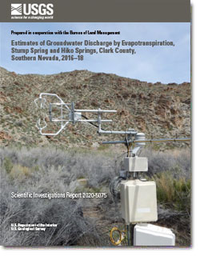Estimates of Groundwater Discharge by Evapotranspiration, Stump Spring and Hiko Springs, Clark County, Southern Nevada, 2016–18
Links
- Document: Report (6.2 MB pdf)
- Data Releases:
- USGS data release - Geospatial data to support estimates of annual groundwater discharge by evapotranspiration from areas of spring-fed riparian vegetation, Stump Spring and Hiko Springs, Clark County, southern Nevada
- USGS data release - Supplemental evapotranspiration gap-filled datasets from Stump Spring and Hiko Springs, Clark County, southern Nevada, 2016–18
- Download citation as: RIS | Dublin Core
Abstract
This report documents methodology and results of a study that estimated groundwater discharge by evapotranspiration (GWET) from phreatophytic vegetation in two desert riparian areas with ephemeral spring discharge in Clark County, southern Nevada. The phreatophytes consisted primarily of western honey mesquite [Prosopis glandulosa var. torreyana (L.D. Benson) M.C. Johnst.] at Stump Spring and mixed shrubs at Hiko Springs. An eddy-covariance station and precipitation gage were established to concurrently measure actual evapotranspiration (AET) and precipitation. Site-scale GWET rates—computed by subtracting measured precipitation from AET—were 239 ±45 millimeters per year (mm/yr) based on measurements over one growing season at Stump Spring and 109 ±27 mm/yr averaged over two growing seasons at Hiko Springs.
The volume of GWET for each groundwater discharge area (GDA) was estimated by developing relations between site-scale computed GWET rates and phreatophytic vegetation represented by a Normalized Difference Vegetation Index (NDVI). A GDA was delineated for the natural drainage in each area by mapping the extent of phreatophytes using high-resolution imagery. A second GDA was delineated at Stump Spring by mapping the extent of phreatophytes in the Area of Critical Environmental Concern (ACEC). Site-scale GWET rates were scaled up by applying the site-based GWET -NDVI relations to NDVI distributions in each GDA. The areas of phreatophytic vegetation within each GDA, area-weighted mean GWET rates, and GWET volumes were as follows: (1) Stump Spring—59 hectares (ha), 126 mm/yr, 7.4 ± 1.4 ×104 cubic meters per year (m3/yr) (60 ± 11 acre-feet/yr); Stump Spring ACEC—49 ha, 98 mm/yr, 4.9 ± 0.9 × 104 m3/yr (39 ± 7 acre-feet/yr); and (2) Hiko Springs—7.2 ha, 112 mm/yr, 0.8 ±0.2 × 104 m3/yr (6.6 ±1.6 acre-feet/yr). The GWET rate computed at Stump Spring compared favorably with published GWET rates for mesquite.
Suggested Citation
Moreo, M.T., Buto, S.G., Smith, D.W., and Nelson, N.C., 2020, Estimates of groundwater discharge by evapotranspiration, Stump Spring and Hiko Springs, Clark County, southern Nevada, 2016–18: U.S. Geological Survey Scientific Investigations Report 2020–5075, 39 p., https://doi.org/ 10.3133/ sir20205075.
ISSN: 2328-0328 (online)
Study Area
Table of Contents
- Abstract
- Introduction
- Study Methods
- Groundwater Discharge by Evapotranspiration
- Summary and Conclusions
- Acknowledgments
- References Cited
- Appendix 1. Selected Daily Evapotranspiration, Energy Balance, and Meteorological Data, Stump Spring and Hiko Springs, 2016–18
| Publication type | Report |
|---|---|
| Publication Subtype | USGS Numbered Series |
| Title | Estimates of groundwater discharge by evapotranspiration, Stump Spring and Hiko Springs, Clark County, southern Nevada, 2016–18 |
| Series title | Scientific Investigations Report |
| Series number | 2020-5075 |
| DOI | 10.3133/sir20205075 |
| Publication Date | July 28, 2020 |
| Year Published | 2020 |
| Language | English |
| Publisher | U.S. Geological Survey |
| Publisher location | Reston, VA |
| Contributing office(s) | Nevada Water Science Center |
| Description | Report: vii, 39 p.; 2 Data Releases |
| Country | United States |
| State | Nevada |
| County | Clark County |
| Online Only (Y/N) | Y |


